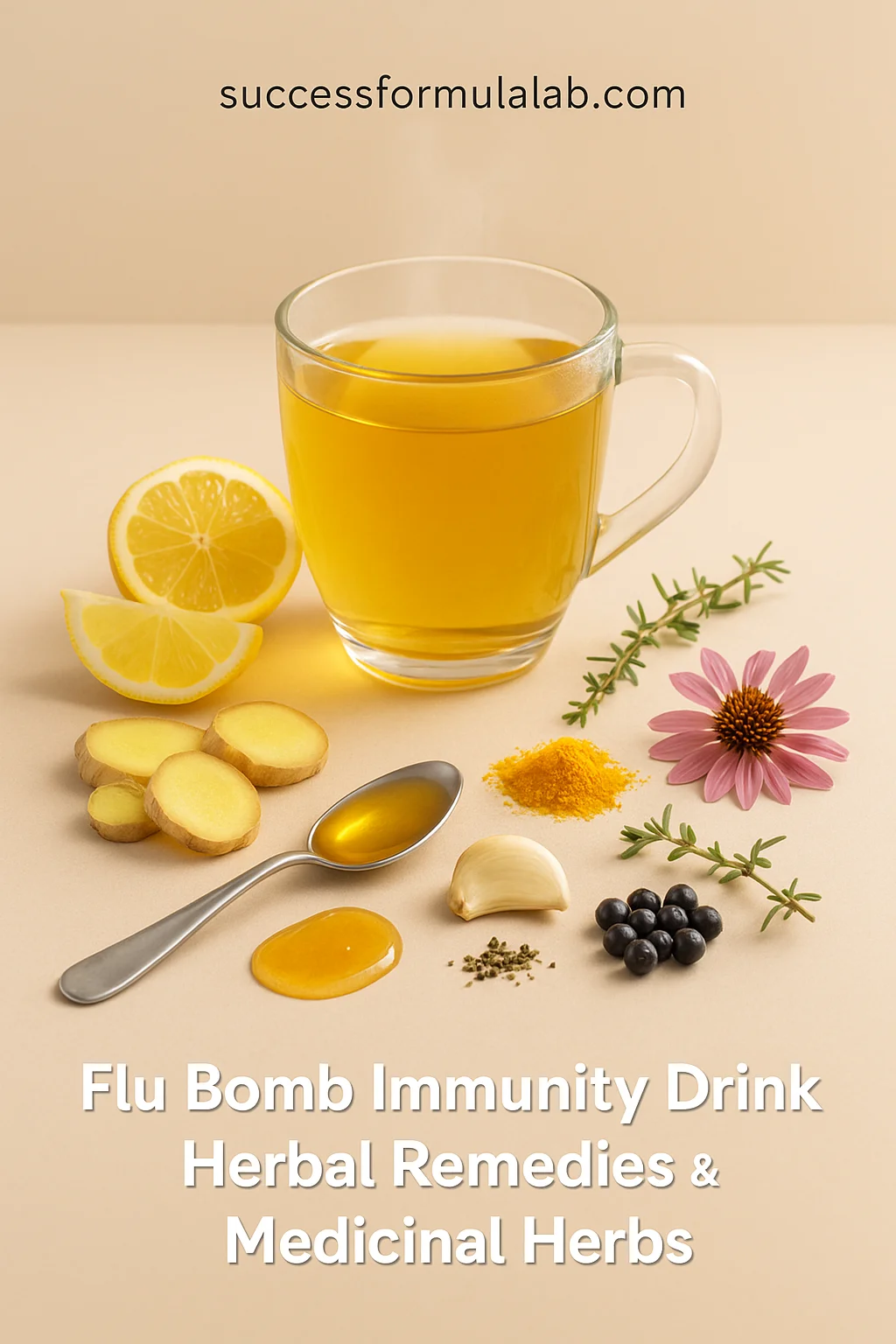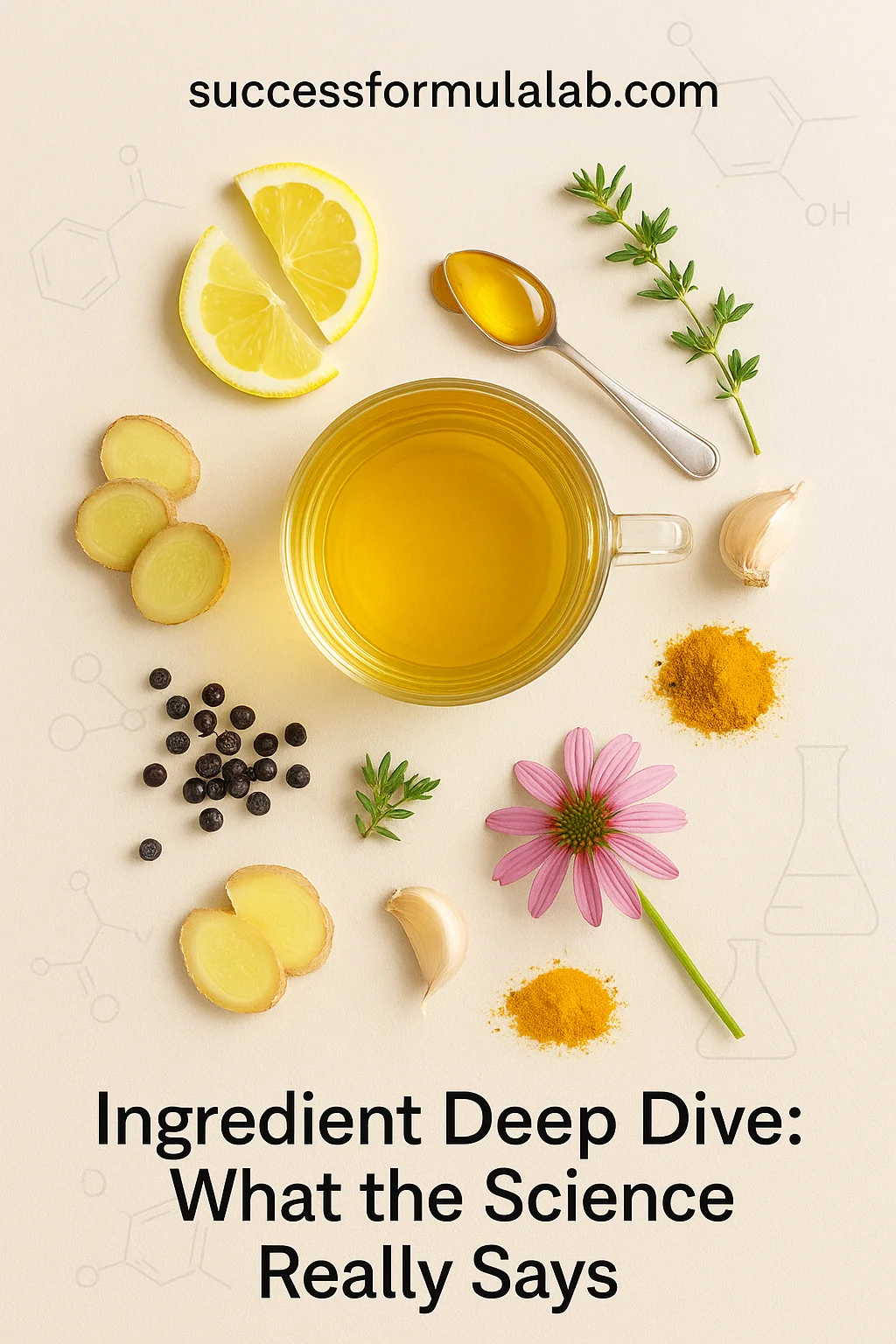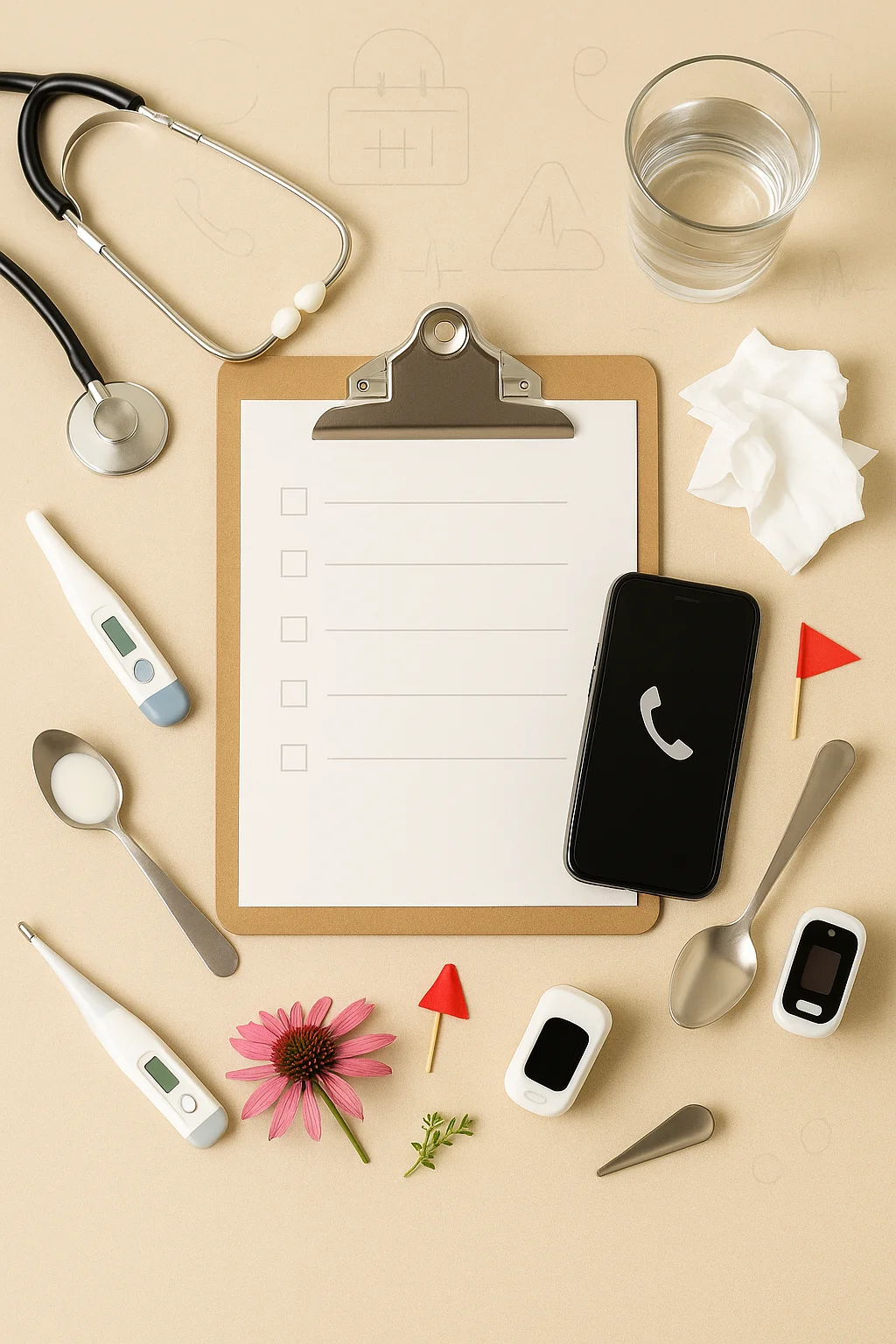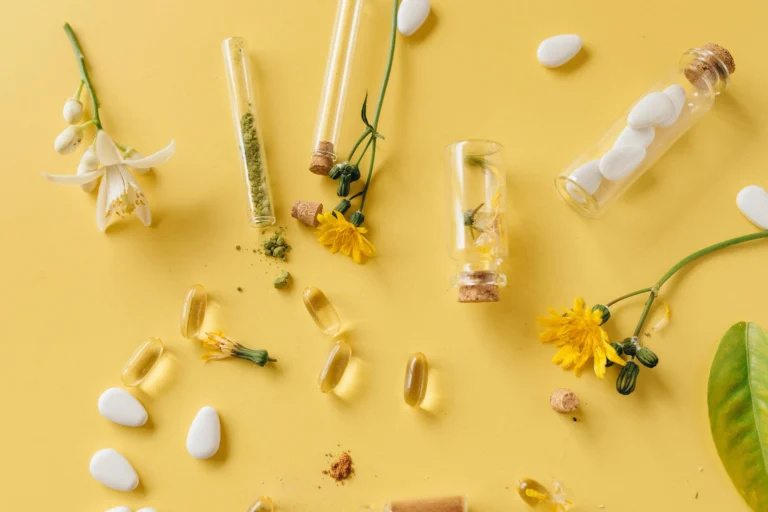That first tickle—why this cozy ritual helps you cope
You know the feeling: a scratchy throat, heavy head, and the quiet worry that a bug is brewing. A warm flu bomb immunity drink won’t cure influenza or the common cold, but it can make you more comfortable while your immune system does the real work.
Helpful resource: Keep soothing herbs at your fingertips by growing a tiny home apothecary with the Medicinal Garden Kit—it shows exactly which plants to grow (ginger, turmeric, chamomile & more) and how to use them.

You’ll hydrate, soothe your throat, and surround yourself with calm, familiar aromas from everyday medicinal herbs like ginger, lemon, turmeric, and thyme. Think of this as a kitchen ritual that supports rest—not a replacement for medical care. For red-flag symptoms (trouble breathing, chest pain or pressure, severe weakness, confusion, little or no urination, or fever/cough that improves and then worsens), contact a clinician promptly. These are recognized emergency warning signs for flu-like illness.
What a “flu bomb immunity drink” actually is
A flu bomb immunity drink is a warm, spiced herbal-citrus tonic you can mix in minutes. You combine fresh ginger, lemon, a soothing sweetener (often honey), turmeric, and a pinch of black pepper; some people add garlic, cayenne, or apple cider vinegar for extra “kick.” The aim is simple: easy sipping, steady fluids, and kitchen-level ingredients that feel gentle and familiar.
Evidence for individual herbs varies—ginger and turmeric are widely studied for comfort and general anti-inflammatory properties; elderberry and echinacea show mixed, preliminary data for cold/flu symptoms; honey can ease cough in people over one year of age. Keep expectations realistic and use culinary amounts.
The master recipe (with fast variations)
“Flu Bomb” Single-Serve Base
Use warm—not boiling—water for a smoother cup.
| Ingredient | Purpose | Adult Amount | Quick Notes & Safety |
|---|---|---|---|
| Fresh ginger, grated | Warming, throat comfort | 1–2 tsp | Generally safe in food amounts; can cause heartburn at higher intakes. |
| Fresh lemon juice | Bright flavor, vitamin C source | 2–3 tbsp | Reduce if reflux-prone. |
| Honey | Soothing sweetness | 1–2 tbsp | Do not give honey to children <1 year due to botulism risk. |
| Turmeric powder | Antioxidant/anti-inflammatory background | ¼–½ tsp | Culinary use is typically well tolerated. |
| Black pepper (pinch) | Helps turmeric absorption; warmth | Pinch | Piperine can raise circulating curcumin levels in small human PK studies. |
| Garlic, crushed (optional) | Pungency; traditional support | ½–1 clove | Limited/mixed clinical data for colds; interaction caution with anticoagulants. |
| Cayenne (optional) | “Clearing” heat | Pinch | Skip if you’re sensitive to spice/ulcers. |
| Apple cider vinegar (optional) | Tangy note | 1 tsp–1 tbsp | Rinse mouth with water after acidic drinks. |
| Warm water | Hydration | 240–300 ml | Top up to taste. |
Directions
-
Crush garlic first (if using) and let it sit 5–10 minutes so key compounds can form.
-
In a mug, add ginger, turmeric, black pepper, and cayenne (if using).
-
Stir in lemon juice, honey, and vinegar.
-
Pour in warm water; taste and adjust.
-
Sip slowly. Most adults enjoy 1–3 mugs/day for a day or two, as tolerated.
Why these choices?
-
Honey can reduce cough frequency/severity in children over one year (and is a soothing demulcent for adults). Never give honey to infants <12 months.
-
Ginger is widely used for comfort and has supportive human data in related contexts (e.g., nausea) with typical culinary safety.
-
Turmeric + black pepper are often paired because piperine (in pepper) can increase circulating curcumin after oral intake; this is pharmacokinetics, not a cure, so keep expectations practical.
Flavor & function upgrades (customize your cup)
Gentle swaps and add-ins
-
Thyme tea base: Steep a fresh sprig or 1 tsp dried thyme for 5–7 minutes for a fragrant, respiratory-friendly base.
-
Cinnamon stick + clove: Round out sourness with warm spice and cozy aroma.
-
Elderberry syrup: Stir in 1–2 tsp for a fruity twist. Some research suggests potential symptom relief when started early; evidence remains preliminary.
-
Echinacea tea: Popular at first signs; research is mixed across many product types.
-
Low-acid version: Reduce lemon/vinegar; emphasize ginger and cinnamon.
-
Vegan: Swap honey for maple or omit sweetener.
Ingredient deep-dive—what the science actually says
Ginger (Zingiber officinale)
How you use it: Grate it fresh for immediate warmth and aroma.
What research shows: Ginger has a long culinary history and is generally safe in food amounts. Clinical literature supports roles in nausea and comfort; side effects can include heartburn or stomach upset in higher intakes. If you take medicines that interact with herbs, talk with a clinician.

Turmeric (Curcuma longa) + Black Pepper (Piper nigrum)
Why you’ll see this pair: Curcumin (from turmeric) has low oral bioavailability; a classic human study found piperine increased circulating curcumin after single doses. That supports the kitchen habit of adding a pinch of pepper.
Safety snapshot: Culinary use is generally well tolerated; rare liver issues have been reported mainly with high-dose supplements or certain formulations—another reason to keep it culinary. If you have gallbladder disease or take multiple medications, get personalized advice first.
Lemon & Honey
Why they belong: Lemon brightens flavor and adds citrus aroma; honey smooths harsh edges and can soothe coughs in those over one year of age. Dosing suggestions for kids vary by age (½–1 tsp), but ask a pediatric clinician if unsure.
Garlic
The role: Crushed garlic brings pungency and volatile compounds many people value during cold season. Evidence for preventing or treating colds is limited and mixed; if you enjoy the flavor, keep it culinary. If you’re on blood thinners, check with your clinician.
Elderberry (Sambucus nigra)
What to know: Preliminary studies suggest elderberry might reduce duration or severity of upper respiratory symptoms when started early, but results are inconsistent and more trials are needed. Avoid raw/uncooked berries and other plant parts; use reputable products.
Helpful resource: Keep soothing herbs at your fingertips by growing a tiny home apothecary with the Medicinal Garden Kit—it shows exactly which plants to grow (ginger, turmeric, chamomile & more) and how to use them.
Echinacea
Where it lands: Systematic reviews show small, inconsistent effects depending on species and preparation; some adults report benefit, others don’t. Short-term use is generally considered safe for most adults, but watch for allergies and interactions, and seek pediatric guidance before giving it to children.
How to use your flu bomb immunity drink (timing, pairing, amounts)
When and how much
-
At first sign: Make one warm mug and sip slowly.
-
Through the day: Another 1–2 mugs if desired.
-
With food: If spices bother your stomach, pair with a light snack.
-
Hydration rule: Keep water intake steady; herbal tea bases (thyme, echinacea) are fine.
What to pair it with
-
Rest routine: Sleep, easy movement, quiet time.
-
Moist air: A cool-mist humidifier or a steamy shower can ease dryness.
-
Nasal care: If you use saline rinses/neti pots, always use distilled/sterile or previously boiled and cooled water—never straight from the tap. This avoids rare but serious infections from waterborne germs.
Safety first—who should be cautious and when to call a clinician

General cautions
-
Honey: Do not give to children under 1 year old.
-
Medication interactions: Ginger/garlic/turmeric can interact with some drugs (e.g., blood thinners) at higher intakes or in supplement form; keep amounts culinary and check with a professional if you take chronic medications.
-
Stomach sensitivity: If you have reflux, ulcers, or gallbladder disease, reduce acids and spices or skip certain add-ins.
When to seek care
Call a clinician promptly if you (or your child) have trouble breathing, chest pain/pressure, confusion, severe weakness, not urinating, seizures, or symptoms that improve then worsen. High-risk groups (older adults, pregnant people, those with chronic conditions or weakened immunity) should check in sooner.
Batch prep & storage (food-safe habits)
3-Cup Concentrate (keeps 3–4 days in the fridge)
-
6 tbsp grated ginger
-
½ cup lemon juice
-
3–6 tbsp honey (to taste)
-
1½ tsp turmeric + ½ tsp black pepper
-
Optional: 2 crushed garlic cloves, ¼ tsp cayenne, 2 tbsp apple cider vinegar
-
720 ml hot water (not boiling)
Cool, bottle, and refrigerate. Shake before use and dilute 1:1 with warm water to serve.
Storage guidance: Use homemade, perishable drinks within 3–4 days under refrigeration; freeze extras as cubes for longer storage (quality is best within a few months).
Troubleshooting taste (so you actually enjoy it)
If it’s too spicy
Add more warm water or a touch of honey/maple. Skip cayenne next time.
If it’s too sour
Reduce lemon/vinegar; add a cinnamon stick while steeping.
If it’s too pungent
Smear in just a trace of garlic or omit; balance with thyme or a clove.
Printable recipe card (table)
Flu Bomb Immunity Drink — Ingredients at a Glance
| Component | Core Option | Optional Boost | Evidence Snapshot | Interaction/Allergy Note |
|---|---|---|---|---|
| Base | Warm water | Thyme or echinacea tea | Hydration supports comfort; evidence for herbs varies by preparation. | Check plant allergies. |
| Citrus | Lemon juice | Orange/grapefruit | Bright flavor; dietary vitamin C source. | Citrus may aggravate reflux. |
| Sweetener | Honey | Maple or no sweetener | Can help relieve cough in kids ≥1 year and adults; never for infants. | Infant botulism risk if <1 year. |
| Heat | Fresh ginger | Cayenne | Comfort; generally safe in foods. | GI sensitivity possible. |
| Color | Turmeric | + pinch black pepper | Piperine raises curcumin levels in small human studies. | Gallbladder/medication cautions—ask your clinician. |
| Pungent | Garlic | — | Traditional use; evidence mixed for colds. | Anticoagulant caution. |
| Fruity add-in | Elderberry syrup | — | Preliminary evidence for URTI symptom relief; quality matters. | Avoid raw/uncooked berries and non-ripe parts. |
FAQs about the flu bomb immunity drink
What is a flu bomb immunity drink, exactly?
It’s a warm, spiced herbal-citrus drink built from ginger, lemon, honey, turmeric, and a pinch of pepper—sometimes garlic, cayenne, or vinegar. It supports comfort and hydration while you rest; individual ingredients have varying levels of evidence.
How often can you drink it?
Most adults do well with 1–3 mugs per day for a couple of days, keeping amounts in the culinary range and listening to your body.
Does it prevent the flu?
No beverage can guarantee prevention. Vaccination, hygiene, timely testing, and clinician-directed antivirals (when appropriate) are your foundation; the drink is for comfort and fluids.
Can kids have a flu bomb immunity drink?
Yes—with milder spices and no honey under age 1. For toddlers and kids, reduce ginger/cayenne and emphasize warm liquids.
Is there a vegan version?
Absolutely. Use maple syrup or skip sweetener altogether.
Can you add elderberry or echinacea?
You can. Research is mixed and preparation-dependent; some studies suggest modest benefits, others show little effect. Use reputable products and start early for the best chance of benefit.
Why the black pepper?
Piperine in pepper increases circulating curcumin in small human pharmacokinetic studies; a pinch is customary, and more isn’t better. Benefits for colds themselves are not proven.
How long does a batch keep?
Refrigerate and use within 3–4 days; freeze extras as cubes for longer storage and quick mug-making later.
What about saline nasal rinses alongside the drink?
Nasal irrigation can ease stuffiness for some people, but only use distilled/sterile or previously boiled and cooled water—never straight from the tap—to avoid rare infections.
comfort in a cup, made your way
When you mix a flu bomb immunity drink, you’re choosing a simple, kitchen-friendly ritual that can soothe a scratchy throat and make sick days gentler. You personalize the heat, the tang, and the sweetness; you keep amounts culinary; and you pair it with rest, hydration, and common-sense care. For anything severe or lingering, you call your clinician. That’s a balanced plan—honest about what we know, careful about what we don’t.
Want these soothing herbs on hand all season?
Start a simple home herb garden with the Medicinal Garden Kit →
Recommended Resources
- Medicinal Garden Kit — grow soothing herbs (calendula, chamomile, thyme, etc.) with step-by-step guidance.
- The Lost Superfoods — shelf-stable comfort foods and broths for easy sick-day meals.
- The Self-Sufficient Backyard — integrate a small herb bed and simple kitchen-garden systems at home.
Ready to make your own flu bomb immunity drink? Brew the master recipe, note your tweaks, and save a small concentrate for tomorrow. If you found a combo that tasted great or helped you feel more comfortable, share your version (and exact ratios) so other readers can craft a cup that works for them, too.

